Site Menu:
| This is an archived Horseadvice.com Discussion. The parent article and menus are available on the navigation menu below: |
| HorseAdvice.com » Diseases of Horses » Lameness » Leg Swellings » Leg Swelling topics not covered above » |
| Discussion on RH swelling for four months, no lameness | |
| Author | Message |
| Member: Kathleen |
Posted on Tuesday, Mar 21, 2006 - 6:31 pm: DrOI think we have discussed this subject in the past, but cannot find anything on HA about Mona and her back end problem (weakness)? Mona is a 20 yr old Arabian mare. She had a collateral ligament problem at the age of two, which caused the lateral wall of her RH to basically roll under (as opposed to flairing out?) The vet and farrier in Nebraska worked on her together for two years and she was doing great. As we've moved around the country, I have not always had the best of luck finding farriers who know how to deal with this. The farrier in Virginia worked for three years to get the foot to a point where it looked fairly normal, was balanced, and she was able to do anything I asked of her and started working off her hind end. We moved to Texas four years ago. Starting about four months ago her RH fetlock started swelling, just above the joint on inside and outside toward the rear (farrier explained it as windpuffs). The swelling has not gone down and since the vet instituted some changes to balance the foot, the swelling is getting worse - but still no lameness. She is a little shortstrided with that leg and there is a very little heat most of the time, but no lameness, no reaction to palpation. The vet checked her when he was seeing her for something else. He did flex test and she trotted out fine. He noted that the hoof walls look different when looking from the front as opposed to looking from the rear. This has always been a problem, one the farrier in Virginia had under control. The hoof is now not balanced and my farrier from Virginia is sending suggestions on how to get her back to the way she was when he was shoeing her, approx 4 years ago. My farrier here in Texas didn't want to make anything but minor changes due to her age and the fact that the farrier (in Texas) who worked on her before him allowed her foot to regress and he didn't feel we should try to do anything but try to maintain soundness. The swelling in her RH started before the vet asked for the changes in shoeing, but has gotten worse with each shoeing. This time, I asked the vet if we could pull the back shoes and see how the foot does on it's own. He agreed to try it for two weeks, then he wanted the shoes back on. I am going to try to post some pictures of the swelling. Would you please give me an opinion of what may be going on and if we should be doing something about it. The swelling has now extended to the whole fetlock, above and to the sided of the fetlock, and into the pastern. She still shows no hint that it bothers her. My concern is that if that joint is weakening, due to time or whatever, maybe we should be doing something about it. The vet has not suggested radiographs, ultrasound, etc. For now, just the shoeing changes. Any suggestions? Kathleen 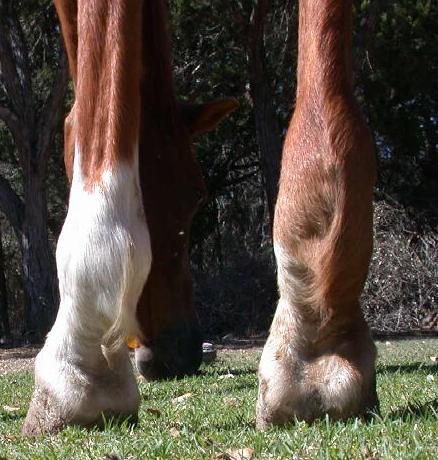 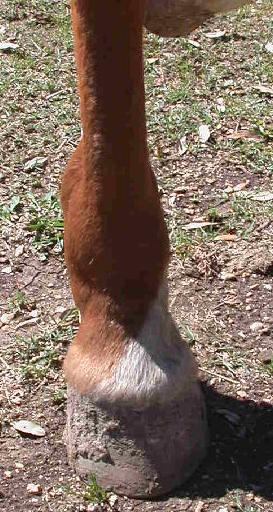 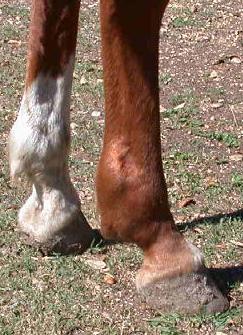 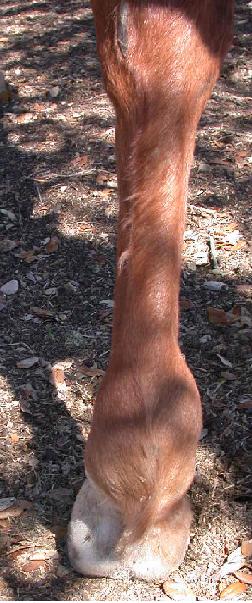
|
| Moderator: DrO |
Posted on Wednesday, Mar 22, 2006 - 9:24 am: The swelling is not primarily in the fetlock joint Kathleen. This is clearly the digital flexor tendon sheath that is markedly distended. The swelling is caused by excess synovial fluid production and indicates the synovial lining is inflamed. Considering this is acute and progressive I would aggressively address it because if you are getting this kind of response in the tendon sheath from an unbalanced foot, the joints of the lower leg including the fetlock must be remarkably stressed and arthritis is sure to follow soon.Finding the cause and correcting it is the first and most important step. This may have been the result of past trauma in which case there is nothing to find. I think a remarkably unbalanced foot could cause stress in the tendon and sheath resulting in the problem so should be addressed. Correcting the imbalance is imperative and if uncertainty about how to do this exists radiographs of the foot and pastern should be taken to guide aligning the bones. If this can be done without shoes fine but may require special shoeing until the foot grows out. While this is going on small paddock rest on level ground is indicated to decrease the stress on this area. There are some specific medical therapies to address the inflammation and you will find those recommendations at, Equine Diseases » Lameness » Diseases of the Lower Limb » Overview of Fetlock (Ankle) Lameness. Check out the Tenosynovitis of the Flexor Tendons heading in that article. DrO |
| Member: Kathleen |
Posted on Wednesday, Mar 22, 2006 - 11:24 pm: DrOThank you very much. I read the article and will contact my vet tomorrow to set up an appointment to check this out again, and will begin your suggestions of rest, bandaging, cold therapy and NSAIDs. By cold therapy I assume you mean cold hosing? As for bandaging, are you referring to standing wraps? Given her extended history of ulcers, would you recommend using bute, or is there something else that would work as well? I will talk to my vet about all of this also, just would like your input to help me prepare to make decisions on what should be done. When the farrier was here last time, he mentioned that I might want to have the farrier who works with my vet take a look at her, since my farrier works with another vet. I'll need to make a decision about that also. Thanks again, Kathleen |
| Moderator: DrO |
Posted on Thursday, Mar 23, 2006 - 9:35 am: Standing wraps will not give the kind of compressive forces needed to remove the fluid from the sheath. For the short term I would use elastic bandage materials as described in Equine Diseases » First Aid » Bandaging Horses for pressure bandages. On the chance this is a chronic problem I would consider purchasing one of the fetlock boots with velcro fasteners and using a lot of cotton padding underneath create a compressive bandage with it.DrO |
| Member: Kathleen |
Posted on Thursday, Mar 23, 2006 - 3:56 pm: DrOBy 'fetlock boot' are you referring to the SMB by Professionals Choice? I have a set of front and rear ones that I have used for years. Would they need to be a size larger than normal to allow for the cotton/gauze? I have an appointment with my vet tomorrow afternoon, and I'll speak with him about all of this when I see him. Kathleen |
| Moderator: DrO |
Posted on Friday, Mar 24, 2006 - 8:08 am: It will depend on how they fit Kathleen, do they do a good job of putting even pressure on the swollen parts? Are there areas that need extra padding? Do they rub her wrong in some areas? Perhaps your veterinarian can help you with these judgements.DrO |
| Member: Kathleen |
Posted on Friday, Mar 24, 2006 - 5:31 pm: DrOJust got back from the vet. When he reexamined the leg, he found a scar and believes that it was trauma that started this. I think I mentioned the wound to him when I first talked to him, but since she had not been lame, he only saw her once and said he just missed it. He believes the swelling we see is scar tissue, said he didn't think there were adhesions. He mentioned that given the wound, she probably would have benefitted from antibiotics, but it is too late now. He likes the way the foot is wearing since we took the shoe off, it is beginning to look almost normal. We have had more progress with that foot since removing the shoe than all the work the farrier has been doing for the last few shoeings. The vet and I talked about the SMB's and I think I understand what needs to be done. BTW she is totally sound, not even shortstrided any more. Apparently, now it is merely cosmetic - I can live with that. Thanks Kathleen |
| Moderator: DrO |
Posted on Saturday, Mar 25, 2006 - 7:04 pm: Super that she is sound but there are still two possible complications:1) Some of these become chronic problems because of fibrin tags that form in the fluid and scar in between the sheath and tendon. 2) Some of these become unstable and the fluid distension chronically worsens ending up with a synovial sheath that is easily inflamed. Do all you can to reduce the inflammation and swelling as rapidly as possible then manage to keep it away. Until the acute swelling has resolved I still think restricted exercise important but hand walking twice daily important to break any forming tags. DrO |
| Member: Kathleen |
Posted on Saturday, Mar 25, 2006 - 9:15 pm: DrOI am a little confused about what is actually going on in that leg. My vet believes that there is already scarring and that there is really nothing to do. He is a very good vet and I trust him, but I feel that this might benefit from the therapy you have laid out. I asked him about wrapping to get the swelling down. He said we could get the swelling down, but it would come right back. Do you know what he meant by that? To reduce the inflammation, I assume she would need to be on bute for a while. That shouldn't be a problem. Thank you for your advice. I'll do what I can and will let you know how it goes. Kathleen |
| Moderator: DrO |
Posted on Sunday, Mar 26, 2006 - 8:53 am: It is important to remember that the problem is currently not static but worsening. To the extent that the tissues have lost their elasticity from chronic distension he will be right. But some of the more recent acute changes as described in your first post are not "set" yet. If is difficult to know how much you can help but I have seen remarkable improvements in fetlocks like above but it took long term commitment. Concerning specific therapy for that sheath see the article on fetlock lameness I refer you to above.DrO |
| Member: Kathleen |
Posted on Wednesday, Mar 29, 2006 - 4:13 pm: Dr.OI gave Mona 1gm bute am/pm Monday, 1/2gm bute am/pm yesterday (Tuesday), 1/2gm am today. I have been checking the leg once a day to make sure I am not causing a problem with my bandaging. Monday evening and Tuesday evening, the swelling was down a little. This morning I took off the bandage because it rained last night and it was a bit of a mess and had gotten wet. There is more swelling today, mostly in the pastern. The pastern is almost as big around and the fetlock, but still no lameness. I will make sure I bandage it down past the coronet band this time in case the swelling is just moving down to the least restricted space. Since the leg was a little dirty and sweaty, I scrubbed it w/betadine and cold hosed it. I turned her back out in a small paddock to dry and she went flying around like a banshee. At one point, she almost slid to a stop and turned at the same time and then held up the RH (the swollen one) and wouldn't put weight on it for a few seconds, then limped a few steps and then trotted off sound. I haven't put the bandage back on yet. There were no pressure sores or any swellings that could be attributed to improper bandaging. Does this treatment seem reasonable? How long would you continue the bute and the bandaging. Should it stay bandaged 24 hrs a day? Thanks in advance. Kathleen |
| Member: Kathleen |
Posted on Wednesday, Mar 29, 2006 - 5:13 pm: Just took some more pics. The swellings looks more uniform now, rather than 'lumpy' as it was before. Also noticed that the pastern looks swollen from the front, but not from the side.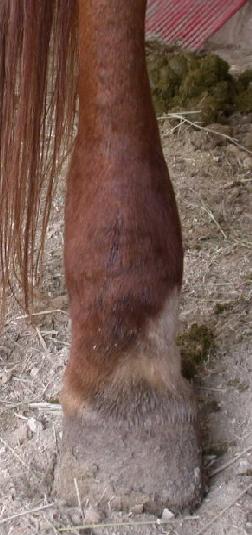 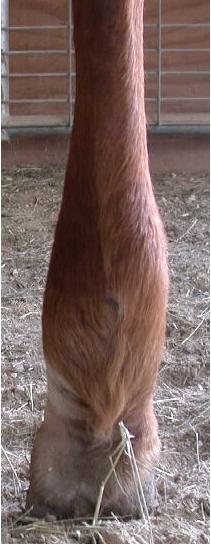 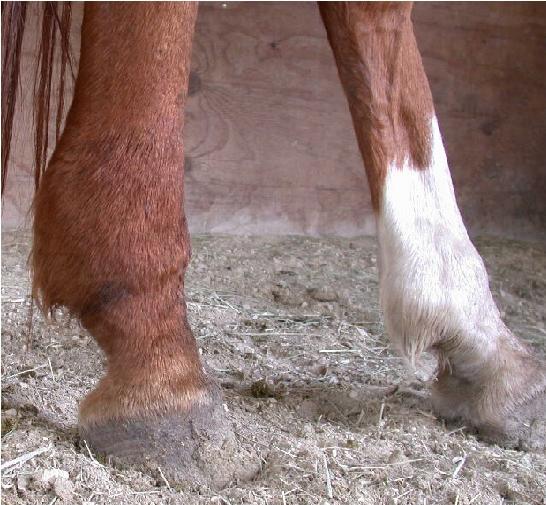 Kathleen |
| Moderator: DrO |
Posted on Wednesday, Mar 29, 2006 - 8:25 pm: Kathleen,Irregular bandaging that is wet and messy when present and flying around in a muddy paddock like a banshee does not exactly sound like what I was thinking appropriate. We need some consistency here. Are you not getting any help from your vet on this? DrO |
| Member: Kathleen |
Posted on Wednesday, Mar 29, 2006 - 8:52 pm: DrOWhat do you mean by irregular bandaging? The only help I'm getting from my vet is the recommendation that if I bandage, then it is 12 hrs on, 12 hrs off. He doesn't believe that there is anything that can be done except let it run it's course. Your approach seemed more logical, so that is what I am trying to do. That's why I asked if I needed to leave the bandages on 24 hr/day, which seems more useful. Since I haven't done this type of pressure wrapping (except for injuries to stop bleeding). I was taking it off to make sure I wasn't creating any pressure points, and then putting it right back on. I hosed her off after scrubbing her leg then turned her out in a small grassy paddock to dry before I rewrapped the leg. It is not normal for her to go crazy like that after I've worked with her. I'm not sure how I could have predicted it. We haven't had rain in so long that I didn't really think about mud, probably should have been prepared, but I wasn't. I believe that the new swelling is 'scratches'. After she dried, I checked it before putting the bandage back on and noted the little bumpy, scabby places covering her pastern to just above the fetlock. She is getting 1/2 gm bute 2x day. Is that enough? If you're still willing to help, is there anything else I can do? Kathleen |
| Moderator: DrO |
Posted on Thursday, Mar 30, 2006 - 7:57 am: I am always willing to help Kathleen, but after reading your post last time I felt a bit like I was spinning my wheels but if your vet is not behind this I can understand your confusion. Perhaps your vet can explain why he thinks this is a bad plan? Does 24 hour bandaging worry him, maybe he knows something here that I am missing. Is he worried about your bandaging skills?I think the on and off (that is what I mean by irregular) just allows the swelling to return between bandages and you cannot allow bandages to get wet and muddy and stay on. I was hoping your vet would help show you how to properly bandage this as the written word can only go so far, you really need to feel how hard to put on the vet wrap and how tight the bandage should feel when done and if you are uncertain how to do this you really need professional supervision the first time. If the scratches does not resolve with just clean, dry bandages, perhaps triple antibiotic with desitin over it for a few bandagings would help. For bute dosages check out, Equine Medications and Nutriceuticals » Anti-inflammatories (NSAID's, Steroids, Arthritis Rx). There are other therapies outlined in the article Equine Diseases » Lameness » Diseases of the Lower Limb » Overview of Fetlock (Ankle) Lameness under the tenosynovitis subtopic. DrO |
| Member: Kathleen |
Posted on Sunday, Apr 9, 2006 - 12:32 pm: DrOHere are some updated pics, I'm still working on it. These are from April 1: 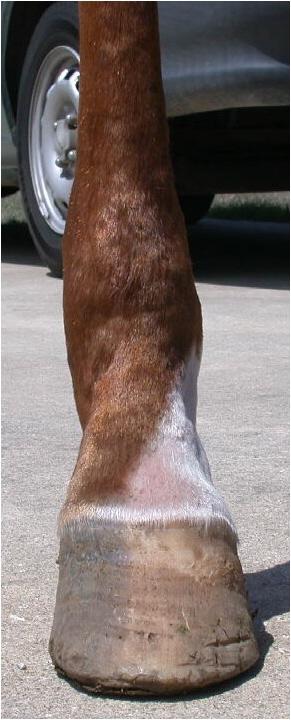 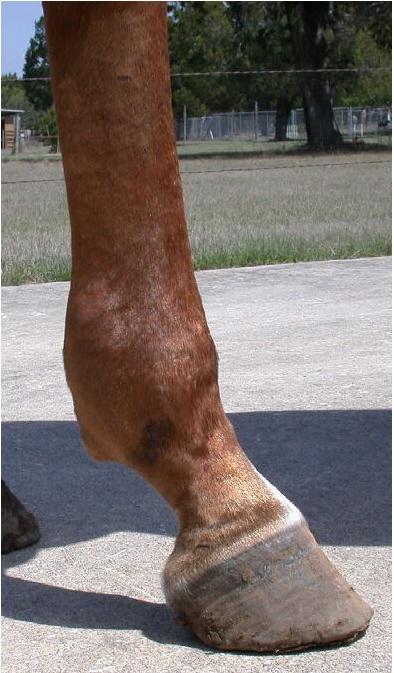 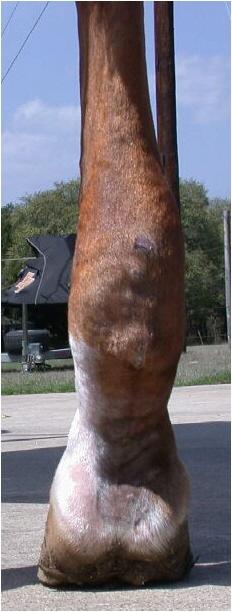
|
| Member: Kathleen |
Posted on Sunday, Apr 9, 2006 - 12:42 pm: Here are some from April 8 (note sore on front view, this showed up when I shaved the leg and noticed the scratches. You can see it in the April 1 pics. The scratches have cleared up, but this is getting worse and bothers her if I touch it, but not otherwise, and she is still sound. I put Di's Liquid bandage on it after scrubbing w/betadine and rewrapped it.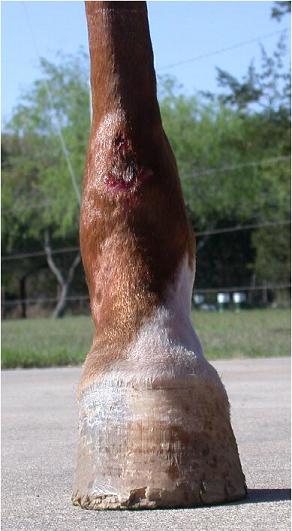 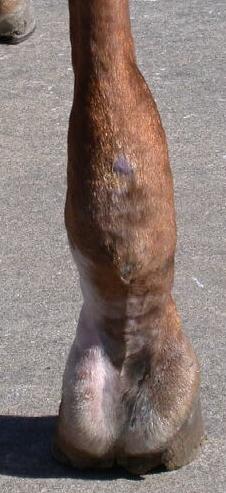
|
| Moderator: DrO |
Posted on Monday, Apr 10, 2006 - 7:59 am: The swelling is much better than the original and a little better than those in March. Are you still keeping it bandaged regularly. If so I wonder if you can make your bandages a bit tighter or have you ever used a clay poltice? It can sometimes deliver pressure where a bandage cannot. Did you ever have the tendon sheath injected? Did you ever start NSAID's?DrO |
| Member: Kathleen |
Posted on Monday, Apr 10, 2006 - 10:32 am: DrOThank you for your encouraging words. Yes, I'm keeping it bandaged, I gave her bute as follows: 1g 2xday for 2 days 1g 1xday for 2 days 1/2g 1xday for 2 days The last dose was April 2, I ran out since I don't keep a lot of that on hand. If I need to keep giving it to her, how much and how long? It does seem not to have improved as much since I stopped giving it to her. I will get more when I talk to my vet today about injecting the tendon sheath. I assume that is still an option. Yes, I can make the bandages tighter and I have poulticed before (many years ago). I read your article on poulticing. Do you recommend premixed or a special mix for this application? I am willing to do whatever is best. The article says leave on for 12 to 48 hrs. How long can/should it be left on? Do I use newspaper so that it will dry or plastic wrap so that it does not dry so quickly? Also, I'm concerned about the sore on the front of the leg. Do I continue to medicate it and use gauze pads on it at the same time as the poultice? I will talk with my vet about all of this today if I can get some time with him, he is usually very good about that. Thank you for any advice you can give. Kathleen |
| Moderator: DrO |
Posted on Tuesday, Apr 11, 2006 - 8:01 am: Either one Kathleen, the premixes I have seen were pretty stiff but that is what you want here. Is that sore from the bandaging?DrO |
| Member: Kathleen |
Posted on Tuesday, Apr 11, 2006 - 11:25 am: DrOThe sore is, we believe, from the scratches - when I shaved her leg this area had a large firm scab. I think I nicked it with the clippers, then rewrapped it without putting anything on it. Vet said to keep putting Di's Liquid bandage or Neosporin on it, check it in 3-4 days and if it gets worse, he wants to give her antibiotics. I bought a premixed poultice called Numotizine Cataplasm. It may be the wrong one. It says to leave on 8 to 12 hrs then remove and reapply as needed (maybe because the active ingredients are no longer active?) Can I leave it on longer, or do I need to use something else. The ingredients are: COUNTERIRRITANT FORMULA: Beechwood Creosote 1.3%, Methyl Salicylate 0.3%, Guaiacol 0.3% CATAPLASM BASE: Polyois 55%, Koalin 43%, Color and Fragrance 0.01% The vets likes the way I'm bandaging and said it could stay on for a week to 10 days max (after the sore is taken care of). We removed the rear shoes last visit 6 weeks ago (he's due tomorrow) to see if the foot would kind of relevel itself. In that respect, the results are amazing. The problem is what I think the vet called 'prolapsed heel'? The heel on the lateral side extends quite a bit behind where it is supposed to be. He wants a bar shoe put back on and the sole/heel in front of the heel to be pared away so that the sole doesn't come in contact with the shoe (about 1/2 inch gap). Trying to encourage the heel to come forward to a fairly normal position. I think I got that right. Here is a pic he was looking at when he made that decision: 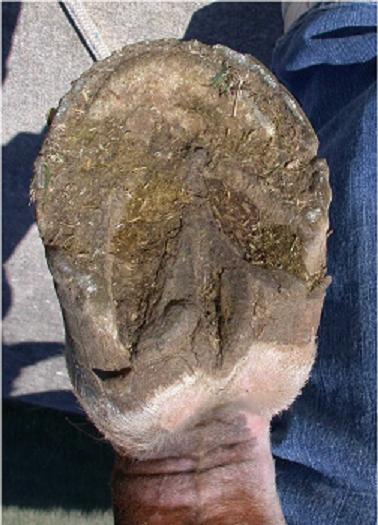 Any comments appreciated. Thanks Kathleen |
| Moderator: DrO |
Posted on Wednesday, Apr 12, 2006 - 7:55 am: Wow Kathleen that is certainly one of the most distorted hoof capsules I have ever seen. Is this the same foot with the swelling? When you say the results are amazing do you mean the foot and pastern are lined up well and the coronet is parrallel with the ground? Besides the prolapsed heel the whole sole and wall on the same time appears to be pulled away and slightly rotated with respect to the frog. What did the foot look like when the shoe came off Kathleen: is this all recent change? If this is long standing distortion you have to be careful if it is functional as defined by the horse being sound. If I were uncertain as to what is new and what is old I think before I would start on the foot I would radiograph to see where the bone is. That said the photo above does shows a heel and really a whole side that is bearing a dissportionate amount of weight and the treatment described above logical if trimming alone cannot get that heel and even part of the quarter off the ground.Really the only active ingredient in the clay poultice is the pressure, the clay helps mold to the legs structures. Both the beechwood creosote and the salicylate are mild counter-irritants so I would check it after 12 hours and if there is no irritation try it 24 hours at a time. I would first go with plastic wrap to keep it soft. If allowed to dry I would change every 12 hours. DrO |
| Member: Kathleen |
Posted on Wednesday, Apr 12, 2006 - 1:09 pm: DrOYes this is the same foot with the swelling. Here is a bottom view and a rear view taken March 1, the day the shoe was removed (before removal - didn't take one after): 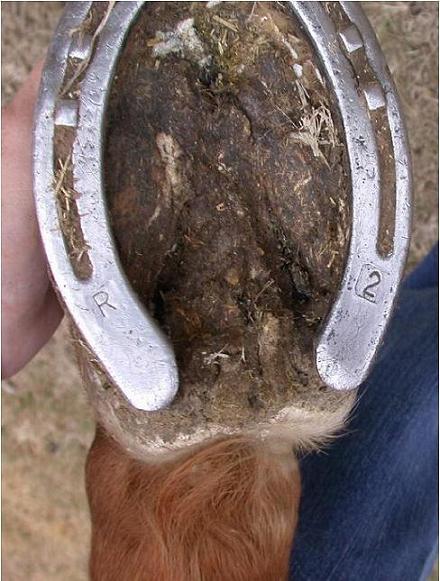 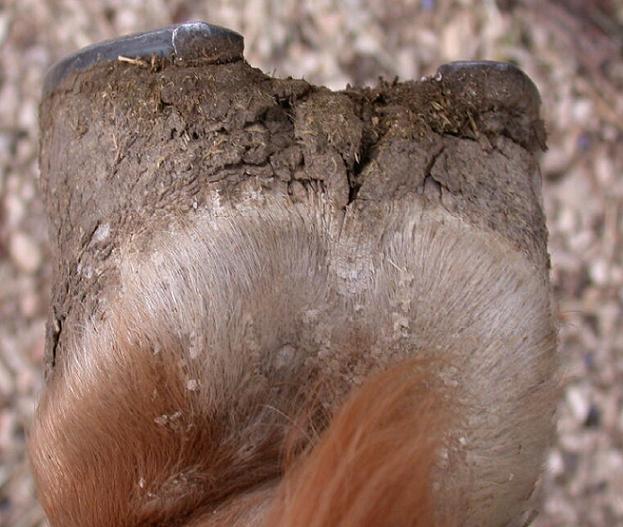 See above post for the one taken April 8. There was recently a little distortion, but it appears to have really changed since the removal of the shoes. We have been working to keep this foot balanced for 18 years and until now were pretty successful. When we left Virginia 4 years ago, the farrier had the foot, pastern, leg, everything lined up, it looked normal and she was able to do just about anything and was using her rear end like she never had before. As for the foot and pastern being lined up, maybe you can get an idea from these pics taken August 12, 2004 - 2 years ago. 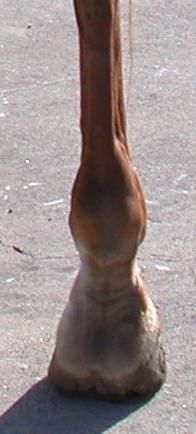 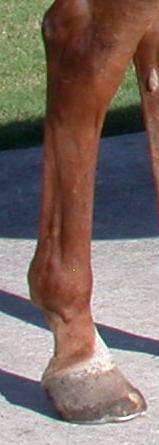 I had taken pictures before we left Virginia so that the farrier here could see what they are supposed to look like. They were in my computer when it crashed, so I now have no reference. The farrier is coming this afternoon (actually he just called and will be here in an hour) and now, with your comments in mind, am a bit worried about what is the right thing to do, but my vet has known Mona for about 14 years (minus the 2 times we moved to Virginia). I feel that he has seen the foot enough to be confident that what he has suggested will be the best thing for her. Not sure the farrier will agree, but I will be as firm and I can be that he follow what Dr Wells has prescribed. Wish us luck Kathleen |
| Moderator: DrO |
Posted on Thursday, Apr 13, 2006 - 8:26 am: I would take my statements above as supportive of your vets plan Kathleen, so do not worry about that. I have gone through the above pictures carefully to construct a history of what I think is happening. Understand that my story is based on the above photos that I will reference below and subject to any errors caused by artifactual data in the photos. First two definitions:
1) The static imbalance of a low heel on the outside (last photo posted on 03/21 and those posted on 04/12 of just prior to removing the shoes) resulted in strain on the flexor tendon and sheath leading to the swelling. 2) Shoes were removed and the foot was brought back into a better static balance (all of the photos posted on 04/09). 3) With the static balance, dynamic balance issues were created, with more pressure on the lateral heel and quarter resulting in a distorted hoof capsule. What your vet proposes is trimming the foot to a confirmation similar to before removeing the shoes, but with one important difference: floating the prolapsed structures above the shoe. This will maintain the alignment of the flexor tendon in a more normal confirmation while relieving the pressure on the prolapsed. The problem is will the foot reshape itself in a manner over time so that both static and dynamic balance are functional. I still recommend radiographs so that a better understanding of the problems with balance are understood, how have the coffin and pastern bones reshaped themselves over the past 2 years. DrO |
| Member: Kathleen |
Posted on Thursday, Apr 13, 2006 - 9:15 am: DrOWell, the farrier was here and he said exactly the same thing as you and Dr Wells, with one exception. He thinks he can achieve what you called the 'dynamic balance' by either trimming or by shoeing in the manner suggested. He agrees with both of you about the suggestion of how to treat this with a bar shoe and the whole thing, but strongly believes he can get the same results without the shoe. So, I told him to go ahead and try it. It was a decision that I wish could be made by someone who can predict the future, but I did what felt right. I will watch her closely. I will also take your advice and make an appointment to have the radiographs done and that may tell us more about how to proceed. I didn't ask if there was anything I could do between trimmings, but I'm not sure he would trust me with a rasp (and probably rightly so). He had mentioned occasionally that he thought the way we were shoeing her was putting too much stress on her leg, but did what we asked. This time he so strongly recommended against putting a shoe back on yet, and that he could accomplish what was needed without one, that he convinced me. The way I understand it, your post above and his explanation of the problem are identical. The difference being the treatment. I hope I made the right decision. I do appreciate your taking time to help with this. It really helps to get the opinion of a qualified and interested third party to help put things in perspective. I'll keep you posted let you know how the xrays turn out. Kathleen |
| Member: Kathleen |
Posted on Thursday, Apr 20, 2006 - 5:45 pm: DrO.Just had xrays done - AP and lateral. Vet said he saw no reason to do more. They look great. He said everything is lined up just as it should be and he likes the way the foot looks and agrees that leaving the shoes off is a good idea, at least as long as the foot is improving as it is. He couldn't believe how good the hoof, pastern, fetlock, etc, line up now and how balanced the hoof looks (so long as you don't look at the bottom). The foot appears to be landing correctly also (my opinion). By the way, the sore on the front of her leg was caused by me, the first time I bandaged her leg. I can't even begin to tell you how bad I feel, but it is healing nicely and the vet said not to worry about it, just keep it wrapped until it heals. From the photo I showed him before, he thought it could have been from the scratches as I thought, but when he saw it today, he said it was definitely caused by the bandaging. Kathleen |
| Moderator: DrO |
Posted on Friday, Apr 21, 2006 - 6:51 am: Let's see, so the bony column is well aligned when radiographed with good static balance but this balance has resulted in excessive weight bearing on the medial heel and quarter causing distortion. So the plan is too trim away a bit more horn on the distorted side but leave the foot barefoot. And you are currently seeing improvement in the irregular appearance at the sole. Do I have this right?DrO |
| Member: Kathleen |
Posted on Friday, Apr 21, 2006 - 1:25 pm: DrOAs far as the trimming, I'm not sure just what the farrier is doing. I'll get more specific info next time. Here is the latest view of the bottom of the foot: April 16, 2006 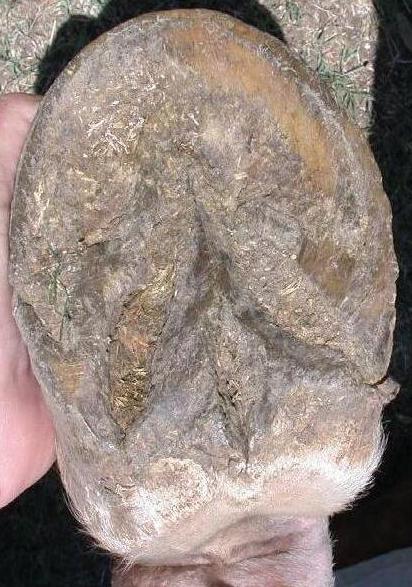 April 8, 2006 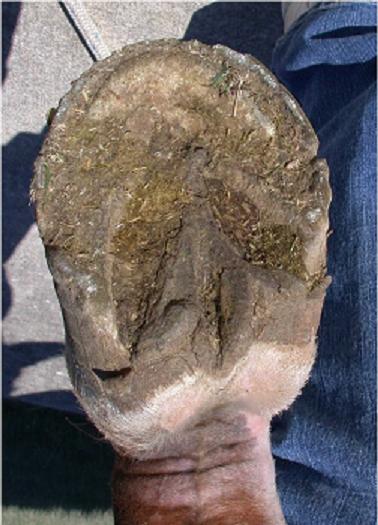
|
| Moderator: DrO |
Posted on Friday, Apr 28, 2006 - 9:40 am: I missed this last Friday Kathleen. Well things do look much more symmetrical, let us know how he is approaching this.DrO |
| Member: Kathleen |
Posted on Friday, Apr 28, 2006 - 2:24 pm: The farrier is due to come back on May 24 and I'll ask him then. I'll take more pictures when I can, I broke my foot day before yesterday and can't do much with the horses without help right now. Will update you when I can.Kathleen |
| Moderator: DrO |
Posted on Saturday, Apr 29, 2006 - 9:35 am: Goodness, an infectious zoonotic "broke foot".DrO |
| Member: Kathleen |
Posted on Saturday, Apr 29, 2006 - 2:03 pm: Ha Ha HaBTW - had to look up zoonotic (I'm not vera bright) Kathleen |
| Member: Kathleen |
Posted on Saturday, Jun 3, 2006 - 8:04 pm: DrOHere are the latest pics of Mona's right hind foot. I took a set the day the farrier worked on her (before he got there). Since I was still in a walking cast and had no one to help, I couldn't get pictures right after he did her. He said he wasn't doing anything special, just keeping the foot in balance. I noticed that he took more off the medial heel, there was more growth there. I lunged her just before he got there and she was just slightly off (head slightly lowers when RH hits the ground) on that RH going in left circle, not noticeable going to right. The problem is, it has swollen and is now worse than when we started and now, as of today, she is noticeably lame on the RH. (The vet told me to stop wrapping her leg and I stopped. I asked if I should do anything to keep the swelling from coming back and he said no, it is chronic now.) I will be taking her back to see him, probably next week, assuming they can get me in. I appreciate any comments, suggestions, tongue lashing, etc that you have to offer. I feel that I am not making the best decisions and Mona is paying the price. She now looks a little uncomfortable moving around in the pasture and I don't see her galloping much and when she trots, it is stiff and not as animated as normal. The farrier said to ride her, but I don't feel right riding a lame horse. Right now, I really don't understand exactly what is going on inside her leg. I don't know if you can help explain it since you can't examine her, but I look forward to any information you can offer. May 24, 2006 - before farrier visit 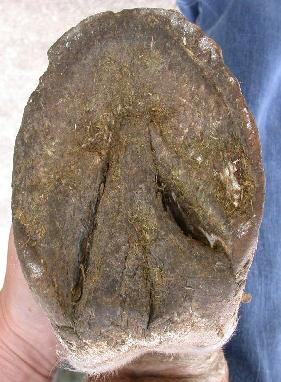 June 3, 2006 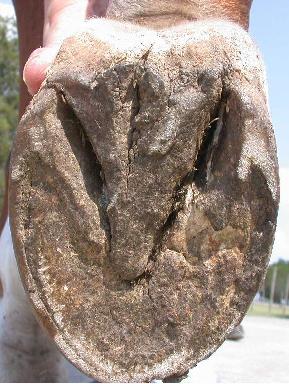 May 24 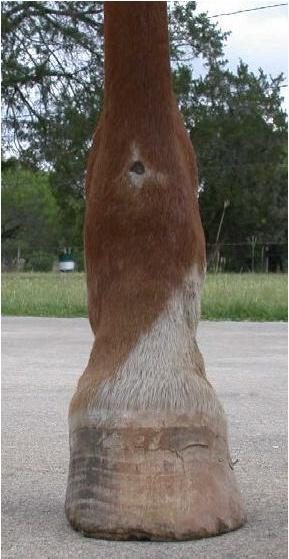 June 3  Thanks Kathleen |
| Moderator: DrO |
Posted on Monday, Jun 5, 2006 - 7:34 am: Not bad Kathleen,The foot certainly looks much better post trim and I disagree the swelling is not as bad as the first shot above but the problem is the lameness. First a head bob is most often associated with front limb lameness, though there are exceptions. Why not get a referral to a large practice or university with a reputation for solving lameness problems? DrO |
| Member: Kathleen |
Posted on Monday, Jun 5, 2006 - 11:04 am: DrO,I have an appointment with my vet this Thursday at 11:00, they need their spring vaccinations, teeth, etc, so he will look at her then. There is a place in Elgin, Tx (2 hrs drive), just outside Austin and there is Texas A&M (3-4 hrs drive), so maybe he can refer us there if he can't figure what to do. There may even be someone in the area. There is a race track (Retama) within 10 minutes of my place, so there should be someone around here who specializes in lameness. I believe that her foot is looking much better, but with the lameness, my vet might suggest putting the shoes back on. I know this vet pretty well and he might suggest that. Would that be a good idea in your opinion? He agreed to taking the shoe off, but wasn't comfortable with leaving it off for very long. The farrier feels very strongly that shoes were making it worse and he wants to keep her back feet barefoot. Do you have any other input before the vet visit? Any questions I should be asking? I would just like to be prepared. Thank you as always Kathleen |
| Moderator: DrO |
Posted on Tuesday, Jun 6, 2006 - 9:13 am: If the lameness is due to sole sensitivity I might try a set of shoes.DrO |
| Member: Kathleen |
Posted on Thursday, Jun 8, 2006 - 5:56 pm: DrO,Just got back from the vet. He referred Mona to a vet at Elgin. We have an appointment next Tuesday. When I watched her move, she isn't actually lame as much as she moves short in the back end. There was no lameness, no head bob, she doesn't seem to be in any real discomfort. He wrote: "right hind flexor tendon & sheath swollen behind fetlock - mild pain with palpation. At trot - NSF. The annular ligament of the right hind appears to be tight". He said that riding her would be good for her right now, unless she seems painful, then stop riding. I guess we'll know more next week. Kathleen |
| Member: Kathleen |
Posted on Wednesday, Jun 14, 2006 - 2:47 pm: DrO,Dr Lewis at Elgin examined Mona, did ultrasound. I don't have any written report yet so I'll try to give you the gist of the visit for now. He said she is slightly lame on the RH. Ultrasound showed tendon is in good shape, tendon sheath is swollen and about 3x normal thickness, annular ligament normal, showed me small pockets of fluid. She shows slight pain on palpation. He said most of the swelling is on the outside, not the part that goes behind the annular ligament, but that there is probably some irritation, thus the pain. He said he has done many annular ligament surgeries, but doesn't see any benefit of surgery on Mona right now due to history of lack of pain and amount of pain right now. There is quite a bit of fibrosis, but not adhesions (if I understood him correctly). He said we really can't tell what caused this. It could be trauma, a foreign body small enough not to show up on ultrasound (said he found a mesquite thorn once with this type of leg), etc. He is hesitant to go in because he is not sure of what he will find. He said he has gone in before and found an abscess and it turned out to be a real mess. Bottom line is the risk is not worth it at this time. He thinks the leg has already gone as far as it is going (I think he was referring to swelling). Give her 6 months, then reevaluate. He recommended she not be ridden now and maybe never if we want her to stay pasture sound, but that could change. If you want more info, I'll have to get the report, because I rarely remember what is said and sometimes misinterpret what is said. As I am writing this, it sounds so clinical and I feel anything but clinical. It breaks my heart that I may never be able to ride her again, but I can accept pasture sound. Kathleen |
| Moderator: DrO |
Posted on Thursday, Jun 15, 2006 - 9:40 am: Kathleen,I am sorry to hear about the findings but there still is about a 60% chance of return to soundness. It does require accurate identification of the problem however. Take a look at this: Vet Comp Orthop Traumatol. 2005;18(4):209-14. Comparison of tenoscopic and ultrasonographic methods of examination of the digital flexor tendon sheath in horses. Edinger J, Mobius G, Ferguson J. Clinic for Orthopaedics in Ungulates, Faculty of Veterinary Medicine, University of Veterinary Medicine, Vienna, Austria. edinger@vetmed.uni-leipzig.de The purpose of this study was to compare sonographic and tenoscopic findings with the purpose of establishing the accuracy and limitations of ultrasonograophy as a non-invasive diagnostic modality in evaluating the DFTS and its enclosed tendons. The medical records from 22 horses which underwent tenoscopic desmotomy of the palmar/plantar annular ligament were evaluated in a retrospective study. The qualitative assessment of sonogrophic and tenoscopic findings were documented for the digital flexor tendon sheath (DFTS), the palmar/plantar annular ligament (PAL), the superficial digital flexor tendon (SDFT) and the deep digital flexor tendon (DDFT). The abnormalities diagnosed sonographically within the DFTS were verifiable tenoscopically with a sensitivity of 90.9% and a specificity of 53.8%. The positive predictive value of sonographic examination at the DFTS was 62.5%. The sensitivity of the sonographic examination at the PAL was 68.8%, the specificity was 50% and the positive predictive value 73.3%. Sonographic examination of the SDF tendons revealed abnormal findings in 12 tendons. The tenoscopic examination confirmed these findings on six tendons when they had a pronounced fibrillated or rough tendon surface or tear on the border. Six superficial flexor tendons and seven deep digital flexor tendons had abnormalities seen tenoscopically which were not visible on sonographic examination. Sonographic examination located lesions of the DDFT in four limbs. On tenoscopic examination the lesions could be detected in seven other DDF tendons, including signs of inflammation at the tendon surface that were not seen ultrasonographically (sensitivity 36.4%). Recognition of the limitations of sonographic results should be kept in mind so as not to misinterpret findings, especially if echogenic materials are observed. This is consistent with several other studies that have come out in the past year that have found tenoscopy often reveals lesions that cannot be found on ultrasound and in these other studies surgery to address these lesions results in a fair prognosis for soundness. I strongly recommend you read the tenosynovitis subtopic at Diseases of Horses » Lameness » Diseases of the Lower Limb » Flexor Tendinitis. If he continues to resist the use of tenoscopy I would certainly ask Dr. Lewis what he thinks about these recent papers. DrO |
| Member: Kathleen |
Posted on Thursday, Jun 15, 2006 - 11:29 am: DrOThank you and I just read the info you suggested and I think I have a little better understanding of the process. As Dr Lewis was doing the ultrasound, he was explaining what he was seeing. If I understood him correctly, the superficial flexor and deep digital flexor tendons were normal. He showed me what the uninjured tendons looked like and then the ones that are involved with this injury and said the damage is in the sheath, not the tendon. If I read the article correctly, the ultrasound might not have picked up on some damage to the tendons that the tenoscopic method would have a better chance of finding. Dr Lewis' main reason for not doing surgery is that she is not really lame and going in could do more harm than good. If I understand the article, there may be more damage than he can see, therefore surgery might be worth the risk, or maybe even that waiting could worsen the prognosis of returning to soundness. Please let me know if I am understanding what you are getting at. Since I have not yet seen the report, I don't have all the information we need and as I said in my last post, I don't guarantee that I understood everything he was saying to us. When I get the report, I will post it here and then maybe we can make some sense of it and then make a plan on what to do next. What I do understand now is that any injury to that part of the leg should be taken very seriously. From what you and Dr Lewis have said, there is a very short period of time to get on top of this type of injury. The problem is that at the time it appeared to be just a little swelling, little to no heat, and no lameness or reaction to palpation at the time. We thought it was related to the changes in her foot. How do you know when to ask for tests that may or may not be necessary? Was this glaringly obvious and nobody but you took it seriously? If it weren't for your information, I might not have kept after the farrier and vet for more answers. At least I kept taking her back to the vet and asking him to keep looking. So as of now, we really don't know what is the right or wrong way to go, but at least we are exploring the options. Thank you for your help Kathleen |
| Moderator: DrO |
Posted on Saturday, Jun 17, 2006 - 4:19 pm: I think you got it. No not glaringly obvious Kathleen but by the time you had posted the pictures the swelling had become quite remarkable and the thing that sent off warning bells to me most was the slow progressive nature of the swelling suggesting that something was getting worse.DrO |
| Member: Kathleen |
Posted on Wednesday, Jul 5, 2006 - 12:23 pm: DrO,Update on Mona. Still do not have the report from Dr Lewis. My vet is keeping on him to get it to him, but so far nothing. In the meantime, Mona has remained sound, no changes in the swelling, but does have a little heat off and on. I told my vet and he said there is nothing I can do at this point, just wait as Dr Lewis said. When I feel heat, my first reaction is to cold hose or ice it, but the vet said it would not help. Do you think icing it would do anything except annoy Mona and give me something to do (I don't really need something to do) or do you think it could help? There was one incident when I went out to the pasture to bring her in and she was holding that RH up and forward, moving it up and down but not touching the ground. It reminded me of seeing Barbaro at the track after his injury, but not near so dire. She put a little weight on it and limped to me and started walking out of it. By the time I got her to the barn, it was almost not noticeable. I gave her bute that night and the next morning and have had no trouble since. Any suggestions other than to wait? Kathleen |
| Moderator: DrO |
Posted on Thursday, Jul 6, 2006 - 11:08 am: Hello Kathleen,With this latest lameness development, until you find out what this is I would suggest you follow the suggestions in our article on First Aid for Lameness. Unless you have remarkable heat and swelling ice would not be part of my recommendations. DrO |
| Member: Kathleen |
Posted on Thursday, Jul 6, 2006 - 11:42 am: DrOI read the article, now I'm trying to figure what applies to Mona's situation. Is this last development considered acute? Or is it just part of the healing process. I did not call my vet, just treated with bute since she walked out of it. Are you suggesting stall rest until we find out more? She is still sound, no reaction to palpation, just a little heat now and then. I feel like I'm a little dense, because I don't understand what I should be doing that I'm not already doing, except for the mention of stall rest. I hesitate to do that because when confined to a stall, she paces back and forth, lifting the front end and turning off the hind end, which twist the legs, so that doesn't seem appropriate. Are we doing harm by allowing her access to pasture? Kathleen |
| Moderator: DrO |
Posted on Friday, Jul 7, 2006 - 10:01 am: That is the problem Kathleen we don’t know what the nature of this bout of lameness. My recommendation is based on a worse case scenario: an acute lameness caused by the chronic changes. It appears to have resolved itself but re-injury is possible. Though it is not exactly clear how the new information will help us in a positive sense, maybe a negative exam will lead be indicative to go back to the pasture?DrO |
| Member: Kathleen |
Posted on Tuesday, Aug 29, 2006 - 10:15 pm: Update on Mona's leg.My vet finally heard from Dr Lewis in Elgin. He said since surgery didn't seem necessary or helpful, he didn't see a need to send a report. At least that is what I understood him to say. My vet said to give her the 6 months and then he will examine her and decide whether to send her back to Dr Lewis or give her more time or start riding her or whatever. The leg seems to be getting bigger and lumpier, but no lameness whatsoever. As a matter of fact, I took Yogi and Annie to the vet and left her at home alone and she did her 'cutting horse' routine at the fence and when we got home, she was covered with sweat on every part of her body. When I hosed her off this is what I found: Mona RH medial 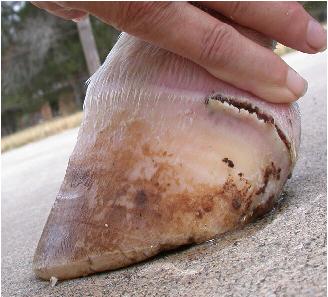 I cleaned it, put antibiotic ointment on it and wrapped it. It doesn't seem to bother her at all. Is there anything else you think I should do? The location bothers me. I have never treated an injury quite like this. What should I expect as it heals. Thanks, Kathleen |
| Moderator: DrO |
Posted on Wednesday, Aug 30, 2006 - 8:21 am: With good care, injuries to the coronet heal quickly and functionally with respect with the tissues job of forming horn. Even wound much worse than the way this one appears in the image.Treat this as suggested in our article on wound care with a mind to keeping the horn dry. There will be a horizontal crack in the horn that will grow out. DrO |
| Member: Kathleen |
Posted on Wednesday, Aug 30, 2006 - 9:26 am: Thank you DrO,If I understand the article, I should keep this one wrapped for a while because there is no way to keep it clean. We just had our first rain in months, so the ground is a bit muddy. I used duct tape on top of the wound dressing, cotton, vet wrap and elasticon. That should keep it dry. As long as it stays dry, how often should I change the bandage? Kathleen |
| Member: Tuckern |
Posted on Wednesday, Aug 30, 2006 - 11:53 am: Hi Kathleen,I have been following your story from the beginning, and my thoughts are with you that you get to the bottom of your mare's situation soon! Regarding the wound to the coronet band, I actually had a very similar thing happen to my mare. And it happened during the one month that it was very wet. I mean, it rained nearly everyday for a month here, so as you can imagine, the paddock was very muddy all the time. I was able to keep the wound clean and dry by using baby diapers. I got the preemie size, the smallest I could find. To wrap, I put the wound ointment on (I use Corona), covered it with a piece of gauze, then I wrapped the diaper around the leg, and put vet wrap over the top, to keep the diaper from getting all soggy and yucky. Then, I used duct tape to "seal" the top and bottom. At first, I duct taped the entire foot, but over time, I modified it to where the duct tape just went half way down the hoof in front, and went down onto the heels in the back. Because of the location, I didn't want to leave the duct tape on for very long without checking it to make sure the heels were okay, so I pretty much changed the wrap every 24 hours or so. I think I kept it wrapped for 4-5 weeks, until the paddock dried up, and the wound closed. As Dr O. mentioned, I did have a line that grew down with the hoof, but once that grew out, I couldn't tell anymore where the wound was. Anyway, just wanted to share. Nicole |
| Member: Kathleen |
Posted on Wednesday, Aug 30, 2006 - 2:12 pm: Nicole,Thank you for thinking of us. How did you keep the bottom of the bandage from wearing through and allowing moisture in. I used duct tape last night and it was worn through on the bottom of the foot, but the wound was dry. I will go out and get diapers today, I had used them before but forgot about it. Thanks for reminding me. Today I used a plastic trash bag over the bandage then duct tape, ran out of elastikon. That usually helps keep the bandage in place. Also used the last of the vet wrap (actually used the greyhound's stash - their skin is so thin that all he has to do is touch something and he bleeds). When I cleaned and rewrapped the wound this morning, I put panalog in the wound and discovered that the area at the heel is about 1/4" deep and goes down the back of the bulb of the heel. The tip of the panalog tube went in about half way. That is the area that bothers me. I am out of vet wrap and just about everything else, so it's off the the store(s). Thanks again, Kathleen |
| Moderator: DrO |
Posted on Wednesday, Aug 30, 2006 - 7:14 pm: I would consider cleaning it once daily but what ever it takes to keep the bandage clean and dry and the wound smelling fresh would be right. Concerning medications I would prefer something more antibacterial than corona but cheaper than Panalog where the expensive corticosteroid is not needed. The article on wound care gives particulars.DrO |
| Member: Kathleen |
Posted on Wednesday, Aug 30, 2006 - 9:15 pm: I bought some nitrofurazone spray today and will use that.Kathleen |
| Member: Choney |
Posted on Wednesday, Aug 30, 2006 - 10:10 pm: Kathleen,You have my sympathies. Your horse is very fortunate to have such a caring and diligent owner. It does remind me of my own horses situation a bit- "prop up one end and the other falls down." ... "if it ain't one thing it's another" and, of course, Murphy's Law. Please continue to update us all on how your horse is doing. Cher |
| Member: Kathleen |
Posted on Thursday, Aug 31, 2006 - 10:08 am: Cher,Thanks for thinking of us. Mona seems to be doing fine. Luckily thru all this, she has shown no sign of pain. Unfortunately our gelding Yogi is in extreme pain from glaucoma and this injury of Mona's just kind of hit me (kind of like the straw that broke the camel's back). My back's not broke yet, but getting close. I'll keep you posted. Thanks again Kathleen |
| Member: Tuckern |
Posted on Thursday, Aug 31, 2006 - 10:16 am: Kathleen,To keep the bottom of the bandage from wearing through, I just used several layers of duct tape. That was another reason I had to change the bandage every day, because if I left much longer, it did start to wear through. But, as long as the wound stays clean, and dry, you should be okay. And in about a week, you'll be a master at wrapping that foot!  Be sure to stock up on lots of vet wrap and duct tape.  I think one roll of vet wrap lasted 2-3 changes. I probably could have gotten away with less, but because of the location of the wound, and the weather, I played it safe. I think one roll of vet wrap lasted 2-3 changes. I probably could have gotten away with less, but because of the location of the wound, and the weather, I played it safe. Nicole |
| Member: Kathleen |
Posted on Thursday, Aug 31, 2006 - 10:38 am: Nicole,Yes, I went out and bought out the store on vet wrap. Since I'll be checking it daily, I'm not so worried about the duct tape wearing through. My vet showed my a way to make a pad (before putting on the foot) using duct tape, alternating layers. It works well and we have been able to keep it on and dry for up to a week at a time. I haven't done it for so long, I forget (I should join in on the HRT discussion going on). Thanks, Kathleen |
| Member: Mrose |
Posted on Thursday, Aug 31, 2006 - 10:41 am: I totally understand that "broken back feeling." Hang in there. You'll get through this. How is Yogi doing? Best thoughts and prayers are with you. |
| Member: Kathleen |
Posted on Thursday, Aug 31, 2006 - 12:09 pm: Sara,Yogi is still in extreme pain. He just stands around, grazes a little, but just looks like he feels horrible. The ophthalmologist said it is probably the worst pain a horse can have, like having the worst headache. I am giving him his meds and they said if he is not better by tomorrow I can add Banamine IM. I don't know if you know or not but his eye problem is posted under a resurrected post - cloudy, runny eye, constricted pupil - I think that is it. I'll feel better when he feels better. Thanks for caring Kathleen BTW I think about Libby often, good luck |
is The Horseman's Advisor
Helping Thousands of Equestrians, Farriers, and Veterinarians Every Day
All rights reserved, © 1997 -
